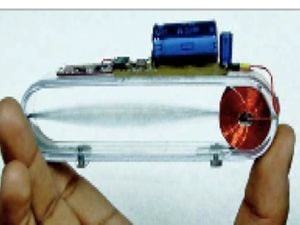No edit summary |
|||
| Line 53: | Line 53: | ||
===Assembly Process/Materials=== | ===Assembly Process/Materials=== | ||
===Electromagnetic Force=== | |||
*[[http://proquest.umi.com.ezproxy.humboldt.edu/pqdlink?index=0&did=280181221&SrchMode=1&sid=1&Fmt=3&VInst=PROD&VType=PQD&RQT=309&VName=PQD&TS=1278905068&clientId=17853|Source from journal]] | |||
**This article explains electromagnetic force in a simple manner. IT talks about a flash light that needs no batteries to operate. The flashlight uses electromagnetic force to power an photo iode, through the movement of magnets in and out of a wire coil. | |||
[[Category:HSU Chiapas Program 2010]] | [[Category:HSU Chiapas Program 2010]] | ||
Revision as of 03:31, 12 July 2010
Intro To Windbelt Project
In order to be successful in our design project, Team A.S.E (Ana,Shane,Enrique) will research the following topics on wind renewable energy:
- Electricity
- Wind Power
- Production Process
- Materials
- Climatology
- WindBelt Trademark
- Energy Efficiency
- Wind Farms
Criteria
To make clear, translucent decisions in the design making process, Team A.S.E will be utilizing the following client criteria; definitions, and weights(scale 0-10) will be included.
Literature Review
Windbelt Trademark
- [Humdinger's]
- Windbelt technology uses a phenomenon called aeroelastic flutter, made famous by the Tacoma Bridge disaster of 1940. Invented by Shawn Frayne, the windbelt is the world's first small scale, turbine free, wind generator. Wind turbines are difficult to scale down in size; The components are expensive and encounter friction as their size decreases. Frayne's study focused on the wind vibrations that caused the failure of the Tacoma bridge, to provide clean, cheap energy to developing countries.The windbelt was originally designed to solve lighting problems of third world countries, yet the device has many applications. An array of windbelts could generate enough power to fuel a laptop, television, or a house. The windbelt pulls energy from the wind with the use of a tensioned membrane. As wind hits the windbelt, the tensioned membrane captures the flutter of the wind. To turn the oscillations of the wind into electricity the windbelt uses of new type of linear generators. This technology comes in a variety of scales, from small handheld windbelts, to windcell panels that can generate megawatts of energy.
Existing Models
the microbelt, seen below in figure 1, can provide clean energy to power the billions of wireless light and power sensors around the world; by using aeroelastic flutter rather than a spinning turbine. The microbelt is able to provide power to wireless sensors as long as there is airflow hitting it. For example, under a car, inside the ducting of buildings, or at the outside of a building.
| Table 1 Specifications | Airflow speed (m/s) | Power output (mW) | |
|---|---|---|---|
| Power Output @ 70 HZ | 3.5 | .2 | |
| N/A | 5.5 | 2.0 | |
| N/A | 7.5 | 5.0 |
- [medium]
- [large]
Assembly Process/Materials
Electromagnetic Force
- [from journal]
- This article explains electromagnetic force in a simple manner. IT talks about a flash light that needs no batteries to operate. The flashlight uses electromagnetic force to power an photo iode, through the movement of magnets in and out of a wire coil.
